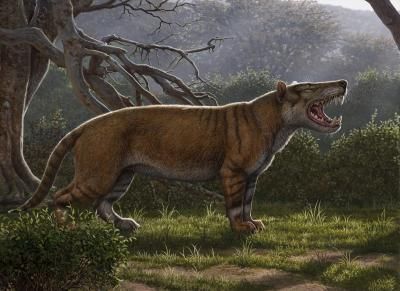
An ancient, enormous "hypercarnivore" that would have eaten the ancestors of hippos and elephants has been discovered in a museum draw. The creature, which has been named Simbakubwa kutokaafrika, lived 22 million years ago and would have been bigger than a saber toothed tiger and a polar bear.
Simbakubwa, meaning "big lion" in Swahili, was found by Nancy Stevens and Matthew Borths, from Ohio University. Part of its jaw, skull and other bones had been stored away in the National Museum of Kenya, having been unearthed decades earlier by scientists looking for evidence of ancient apes at the Meswa Bridge archaeology site.
"[Nancy] was taking stock of everything that had been discovered at Meswa Bridge, when she pulled open the drawer with the Simbakubwa fossils and was amazed to see such a massive carnivore," Borths told Newsweek.
The team has now published a study of the fossils in the Journal of Vertebrate Paleontology. The bones and teeth recovered appear to be a creature that died in relatively early adulthood. It was likely to apex predator of the time, Borths said. "Simbakubwa was larger than a saber-toothed cat and larger than a polar bear, the largest land-based mammalian carnivore alive today," he said. "Like a saber-toothed cat, Simbakubwa was a hypercarnivore, but cats only have one set of specialized, meat-slicing teeth on each side of the jaw. Simbakubwa had three. Saber-toothed cats and Simbakubwa missed each other by about eight million years.
Speculating on its diet, he added: "Simbakubwa was a hypercarnivore, which means it has specialized, scissor-like pairs of teeth that would have helped it efficiently slice through meat. Some of the herbivores known from the site that might have been on the menu include anthracotheres—lanky hippo relatives—and elephant relatives like the long-tusked mastodon Zygolophodon."

Simbakubwa's ancestors would have been small, weasel sized animals that emerged just after the extinction of the dinosaurs, around 66 million years ago. The species belongs to a group of extinct mammals called hyaenodonts. These were the first carnivorous mammals in Africa.
Eventually, as the continents moved and Africa was connected with the other continents, animals started dispersing around the globe. At this point, researchers believe the ancestors of big cats and dogs started to arrive in Africa in the south, while Simbakubwa may have started to venture north. At some point, the species went extinct. While the reasons for this are unclear, Borths said the arrival of modern carnivores coupled with climate change may have caused problems for the giant predator.
"As modern carnivores moved from Eurasia into Africa, many moved into medium to small-sized niches and hyaenodonts like Simbakubwa became specialized hypercarnivores at the top of the food chain," he said. "However, this was a period of extreme environmental change. When Africa connected with Eurasia the continents changed ocean currents and global climate patterns, the uplift of the East African Rift changed precipitation patterns, and closed forest habitats started to become more open and grassy. Prey populations would have changed in response to all of this climatic turmoil and the apex carnivores at the time happened to be hyaenodonts.
"With an unstable ecosystem, they were vulnerable—just as apex predators like lions and polar bears are vulnerable to environmental change today."
Uncommon Knowledge
Newsweek is committed to challenging conventional wisdom and finding connections in the search for common ground.
Newsweek is committed to challenging conventional wisdom and finding connections in the search for common ground.
About the writer
Hannah Osborne is Nesweek's Science Editor, based in London, UK. Hannah joined Newsweek in 2017 from IBTimes UK. She is ... Read more
To read how Newsweek uses AI as a newsroom tool, Click here.








